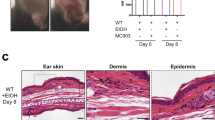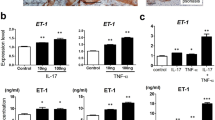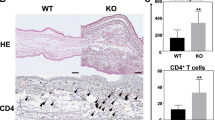Abstract
IL-10 is overexpressed in skin lesions of atopic dermatitis (AD) patients and believed to be an important factor in the pathogenesis of the disease. Thus the regulation of IL-10 production is a potential solution for immunotherapeutic intervention in AD. We examined the topical delivery of an antisense oligonucleotide for mouse IL-10 (AS6) and the therapeutic effect on the skin lesions of NC/Nga mice, a human AD model. Using an iontophoresis system, about 30% of the applied dose of AS6 penetrated the skin and was distributed in the epidermis and upper dermis. Topically delivered AS6 decreased the levels of mRNA and protein of IL-10 in the lesions of NC/Nga mice, with no effect on IL-4 levels. The dorsal lesions of NC/Nga mice disappeared with repeated topical application of AS6. Topically delivered AS6 showed an inhibitory effect on the production of IL-10 in the skin lesions of NC/Nga mice and had a therapeutic effect on the established dermatitis.
This is a preview of subscription content, access via your institution
Access options
Subscribe to this journal
Receive 12 print issues and online access
$259.00 per year
only $21.58 per issue
Buy this article
- Purchase on Springer Link
- Instant access to full article PDF
Prices may be subject to local taxes which are calculated during checkout





Similar content being viewed by others
References
Cooper KD . Atopic dermatitis: recent trends in pathogenesis and therapy. J Invest Dermatol 1994; 102: 128–137.
Rudikoff D, Lebwohl M . Atopic dermatitis. Lancet 1998; 351: 1715–1721.
Soter NA . Morphology of atopic eczema. Allergy 1989; 44 (Suppl 9): 16–19.
Uehara M, Izukura R, Sawai T . Blood eosinophilia in atopic dermatitis. Clin Exp Dermatol 1990; 15: 264–266.
Grewe M et al. A role for Th1 and Th2 cells in the immunopathogenesis of atopic dermatitis. Immunol Today 1998; 19: 359–361.
Pastore S et al. Granulocyte macrophage colony-stimulating factor is overproduced by keratinocytes in atopic dermatitis. Implications for sustained dendritic cell activation in the skin. J Clin Invest 1997; 99: 3009–3017.
Ying S et al. The kinetics of allergen-induced transcription of messenger RNA for monocyte chemotactic protein-3 and RANTES in the skin of human atopic subjects: relationship to eosinophil, T cell, and macrophage recruitment. J Exp Med 1995; 181: 2153–2159.
Ohmen JD et al. Overexpression of IL-10 in atopic dermatitis. Contrasting cytokine patterns with delayed-type hypersensitivity reactions. J Immunol 1995; 154: 1956–1963.
Vestergaard C et al. Overproduction of Th2-specific chemokines in NC/Nga mice exhibiting atopic dermatitis-like lesions. J Clin Invest 1999; 104: 1097–1105.
Vestergaard C et al. IL-10 augments the IFN-gamma and TNF-alpha induced TARC production in HaCaT cells: a possible mechanism in the inflammatory reaction of atopic dermatitis. J Dermatol Sci 2001; 26: 46–54.
Cohen SB et al. Interleukin-10 rescues T cells from apoptotic cell death: association with an upregulation of Bcl-2. Immunology 1997; 92: 1–5.
Orteu CH et al. The inhibition of cutaneous T cell apoptosis may prevent resolution of inflammation in atopic eczema. Clin Exp Immunol 2000; 122: 150–156.
Akdis M et al. Cytokine network and dysregulated apoptosis in atopic dermatitis. Acta Odontol Scand 2001; 59: 178–182.
Matsuda H et al. Development of atopic dermatitis-like skin lesion with IgE hyperproduction in NC/Nga mice. Int Immunol 1997; 9: 461–466.
Vestergaard C, Yoneyama H, Matsushima K . The NC/Nga mouse: a model for atopic dermatitis. Mol Med Today 2000; 6: 209–210.
Matsumoto M et al. IgE hyperproduction through enhanced tyrosine phosphorylation of Janus kinase 3 in NC/Nga mice, a model for human atopic dermatitis. J Immunol 1999; 162: 1056–1063.
Agrawal S, Zhao Q . Antisense therapeutics. Curr Opin Chem Biol 1998; 2: 519–528.
Crooke ST . Antisense therapeutics. Biotechnol Genet Eng Rev 1998; 15: 121–157.
Arima H et al. Specific inhibition of interleukin-10 production in murine macrophage-like cells by phosphorothioate antisense oligonucleotides. Antisense Nucleic Acid Drug Dev 1998; 8: 319–327.
Merino V, Kalia YN, Guy RH . Transdermal therapy and diagnosis by iontophoresis. Trends Biotechnol 1997; 15: 288–290.
Guy RH . Iontophoresis – recent developments. J Pharm Pharmacol 1998; 50: 371–374.
Regnier V, Preat V . Localization of a FITC-labeled phosphorothioate oligodeoxynucleotide in the skin after topical delivery by iontophoresis and electroporation. Pharm Res 1998; 15: 1596–1602.
Kay AB et al. Messenger RNA expression of the cytokine gene cluster, interleukin 3 (IL-3), IL-4, IL-5, and granulocyte/macrophage colony-stimulating factor, in allergen-induced late-phase cutaneous reactions in atopic subjects. J Exp Med 1991; 173: 775–778.
Regnier V, De Morre N, Jadoul A, Preat V . Mechanisms of a phosphorothioate oligonucleotide delivery by skin electroporation. Int J Pharm 1999; 184: 147–156.
Brand RM, Hannah TL, Norris J, Iversen PL . Transdermal delivery of antisense oligonucleotides can induce changes in gene expression in vivo. Antisense Nucleic Acid Drug Dev 2001; 11: 1–6.
Anigbogu A et al. An in vivo investigation of the rabbit skin responses to transdermal iontophoresis. Int J Pharm 2000; 200: 195–206.
Burnette RR, Ongpipattanakul B . Characterization of the pore transport properties and tissue alteration of excised human skin during iontophoresis. J Pharm Sci 1988; 77: 132–137.
Leung DY . Atopic dermatitis: the skin as a window into the pathogenesis of chronic allergic diseases. J Allergy Clin Immunol 1995; 96: 302–318; quiz 319.
Leung DY, Bhan AK, Schneeberger EE, Geha RS . Characterization of the mononuclear cell infiltrate in atopic dermatitis using monoclonal antibodies. J Allergy Clin Immunol 1983; 71: 47–56.
Novak N, Bieber T, Katoh N . Engagement of Fc epsilon RI on human monocytes induces the production of IL-10 and prevents their differentiation in dendritic cells. J Immunol 2001; 167: 797–804.
Nakagawa H et al. Tacrolimus ointment for atopic dermatitis. Lancet 1994; 344: 883.
Hiroi J et al. Effect of tacrolimus hydrate (FK506) ointment on spontaneous dermatitis in NC/Nga mice. Jpn J Pharmacol 1998; 76: 175–183.
Nakamura H et al. Prevention and regression of atopic dermatitis by ointment containing NF-kB decoy oligodeoxynucleotides in NC/Nga atopic mouse model. Gene Therapy 2002; 9: 1221–1229.
Kakinuma T et al. Thymus and activation-regulated chemokine in atopic dermatitis: serum thymus and activation-regulated chemokine level is closely related with disease activity. J Allergy Clin Immunol 2001; 107: 535–541.
Berin MC, Eckmann L, Broide DH, Kagnoff MF . Regulated production of the T helper 2-type T-cell chemoattractant TARC by human bronchial epithelial cells in vitro and in human lung xenografts. Am J Respir Cell Mol Biol 2001; 24: 382–389.
Chomczynski P, Sacchi N . Single-step method of RNA isolation by acid guanidinium thiocyanate–phenol–chloroform extraction. Anal Biochem 1987; 162: 156–159.
Acknowledgements
We are grateful to Miss Misaki Matsuda, Miss Shiho Yamaoka, and Mr Takahiro Wada for technical assistance. We are also grateful to Hisamitsu Pharmaceutical Co., Ltd for supplying the iontophoretic apparatus ADIS-4030.
Author information
Authors and Affiliations
Rights and permissions
About this article
Cite this article
Sakamoto, T., Miyazaki, E., Aramaki, Y. et al. Improvement of dermatitis by iontophoretically delivered antisense oligonucleotides for interleukin-10 in NC/Nga mice. Gene Ther 11, 317–324 (2004). https://doi.org/10.1038/sj.gt.3302171
Received:
Accepted:
Published:
Issue Date:
DOI: https://doi.org/10.1038/sj.gt.3302171
Keywords
This article is cited by
-
Antisense Targeting of cFLIP Sensitizes Activated T Cells to Undergo Apoptosis and Desensitizes Responses to Contact Dermatitis
Journal of Investigative Dermatology (2009)
-
Changes in Immune Responses to Antigen Applied to Tape-Stripped Skin with CpG-Oligodeoxynucleotide in NC/Nga Mice
Pharmaceutical Research (2005)



